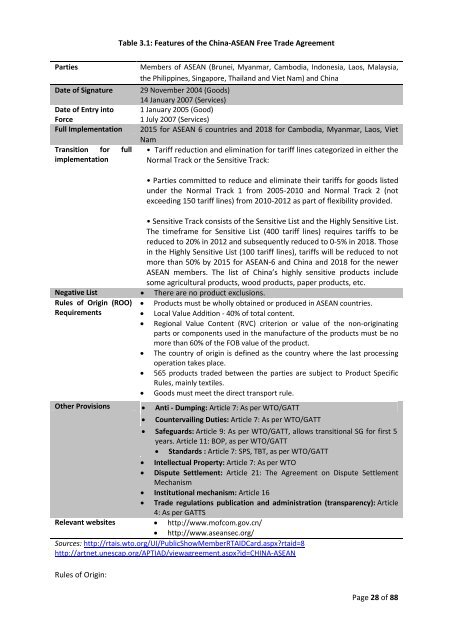Create successful ePaper yourself
Turn your PDF publications into a flip-book with our unique Google optimized e-Paper software.
Table 3.1: Features of the <strong>China</strong>-ASEAN <strong>Free</strong> <strong>Trade</strong> <strong>Agreement</strong><br />
Parties<br />
Date of Signature<br />
Date of Entry into<br />
Force<br />
Full Implementati<strong>on</strong><br />
Transiti<strong>on</strong> for full<br />
implementati<strong>on</strong><br />
Members of ASEAN (Brunei, Myanmar, Cambodia, Ind<strong>on</strong>esia, Laos, Malaysia,<br />
the Philippines, Singapore, Thailand and Viet Nam) and <strong>China</strong><br />
29 November 2004 (Goods)<br />
14 January 2007 (Services)<br />
1 January 2005 (Good)<br />
1 July 2007 (Services)<br />
2015 for ASEAN 6 countries and 2018 for Cambodia, Myanmar, Laos, Viet<br />
Nam<br />
• Tariff reducti<strong>on</strong> and eliminati<strong>on</strong> for tariff lines categorized in either the<br />
Normal Track or the Sensitive Track:<br />
• Parties committed to reduce and eliminate their tariffs for goods listed<br />
under the Normal Track 1 from 2005-2010 and Normal Track 2 (not<br />
exceeding 150 tariff lines) from 2010-2012 as part of flexibility provided.<br />
• Sensitive Track c<strong>on</strong>sists of the Sensitive List and the Highly Sensitive List.<br />
The timeframe for Sensitive List (400 tariff lines) requires tariffs to be<br />
reduced to 20% in 2012 and subsequently reduced to 0-5% in 2018. Those<br />
in the Highly Sensitive List (100 tariff lines), tariffs will be reduced to not<br />
more than 50% by 2015 for ASEAN-6 and <strong>China</strong> and 2018 for the newer<br />
ASEAN members. The list of <strong>China</strong>’s highly sensitive products include<br />
some agricultural products, wood products, paper products, etc.<br />
Negative List • There are no product exclusi<strong>on</strong>s.<br />
Rules of Origin (ROO)<br />
Requirements<br />
• Products must be wholly obtained or produced in ASEAN countries.<br />
• Local Value Additi<strong>on</strong> - 40% of total c<strong>on</strong>tent.<br />
• Regi<strong>on</strong>al Value C<strong>on</strong>tent (RVC) criteri<strong>on</strong> or value of the n<strong>on</strong>-originating<br />
parts or comp<strong>on</strong>ents used in the manufacture of the products must be no<br />
more than 60% of the FOB value of the product.<br />
• The country of origin is defined as the country where the last processing<br />
operati<strong>on</strong> takes place.<br />
• 565 products traded between the parties are subject to Product Specific<br />
Rules, mainly textiles.<br />
• Goods must meet the direct transport rule.<br />
Other Provisi<strong>on</strong>s • Anti - Dumping: Article 7: As per WTO/GATT<br />
• Countervailing Duties: Article 7: As per WTO/GATT<br />
• Safeguards: Article 9: As per WTO/GATT, allows transiti<strong>on</strong>al SG for first 5<br />
years. Article 11: BOP, as per WTO/GATT<br />
• Standards : Article 7: SPS, TBT, as per WTO/GATT<br />
• Intellectual Property: Article 7: As per WTO<br />
• Dispute Settlement: Article 21: The <strong>Agreement</strong> <strong>on</strong> Dispute Settlement<br />
Mechanism<br />
• Instituti<strong>on</strong>al mechanism: Article 16<br />
• <strong>Trade</strong> regulati<strong>on</strong>s publicati<strong>on</strong> and administrati<strong>on</strong> (transparency): Article<br />
4: As per GATTS<br />
Relevant websites • http://www.mofcom.gov.cn/<br />
• http://www.aseansec.org/<br />
Sources: http://rtais.wto.org/UI/PublicShowMemberRTAIDCard.aspx?rtaid=8<br />
http://artnet.unescap.org/APTIAD/viewagreement.aspx?id=CHINA-ASEAN<br />
Rules of Origin:<br />
Page 28 of 88



